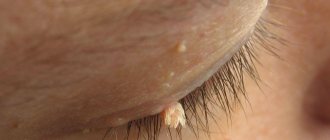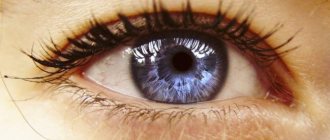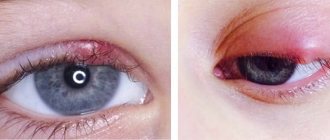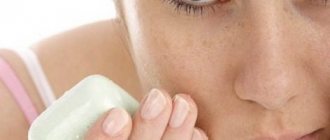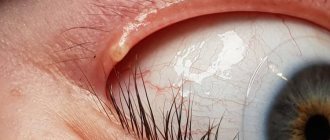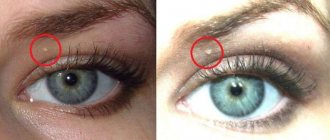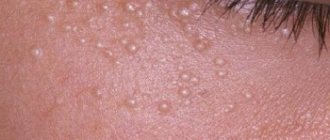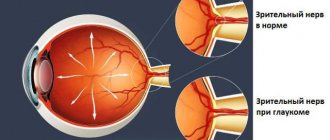Despite the small surface area of the eyelid, it plays an important role in protecting the eyeball.
The skin does not have subcutaneous fatty tissue and is the thinnest in the body.
The eyelids are prone to the development of benign and malignant tumors. One study found that 5 to 10% of all skin cancers occur on the eyelids.
The term "papilloma" refers to a group of various benign epithelial proliferations that affect the skin of the eyelids. These lesions are not necessarily associated with the papilloma virus. The damage is not dangerous, but causes mild irritation. It is important to be able to differentiate a benign lesion, such as a papilloma, from a potentially malignant one on the eyelid.
Lesions that fall into this classification include, but are not limited to, seborrheic keratosis, pseudoepitheliomatous hyperplasia, inverted keratosis follicularis, verruca vulgaris, plano (acrochordon/skin tag), basosquamous acanthoma, and acanthoma planum.
Causes
The etiology depends on the type of epithelial proliferation. Squamous and seborrheic keratoses are idiopathic benign cell proliferations. There is no known definitive cause for the growths.
However, malignant skin lesions that look like papillomas are often associated with chronic ultraviolet exposure and sun-damaged skin. Verruca vulgaris is caused by human papillomavirus type 6 or 11.
One of the most common causes is HPV. However, inverted papilloma is usually caused by smoking.
Sometimes, skin damage develops due to the presence of other malignancies. There is a link between cancer and HPV, especially cervical cancer.
The study showed that, in general, epidermal tumors make up the majority of eyelid tumors. Seborrheic keratosis is the most common lesion, followed by squamous cell papilloma.
Another study reported that squamous cell is the most common benign epithelial tumor of the eyelid.
Seborrheic keratosis occurs in middle-aged or elderly patients. Squamous cell papillomas are not biased towards a particular race or gender. They tend to increase in frequency with age but occur at any age.
Symptoms
General symptoms of papillomatous formations:
- difficulty closing the eyelids completely;
- dry mucous membrane;
- the development of an inflammatory process, which is accompanied by swelling of the eyelid and hyperemia;
- permanently present capillary network;
- discharge of pus due to the development of a secondary inflammatory disease of the eyeball.
How to distinguish the type of disease by appearance
Squamous cell papilloma is known as acrochordon or skin tag. It is a soft, flesh-colored lesion that is smooth, round, and/or pedunculated.
Seborrheic keratosis is a benign cell proliferation. Classically has a flat appearance and varying degrees of pigmentation. The lesions typically range from pink or flesh-colored to dark brown.
They are well defined and usually slightly raised. The lesions are benign, but the sudden appearance of multiple seborrheic keratoses anywhere on the body indicates a paraneoplastic process. The formations often have an inflamed base. This is called the Leser-Trélat sign.
Pseudoepitheliomatous hyperplasia is a reactive process in response to trauma, wounds, burns, pharmaceuticals, etc. The formations are similar to basal cell or squamous cell carcinoma.
Inverted keratosis pilaris is a single lesion affecting the eyelid margin. Characterized by pigmentation, nodular or papillary in appearance.
Verruca vulgaris (common wart) is a flesh-colored skin growth caused by the human papillomavirus. Involvement of the eyelids is rare.
Histopathology
Seborrheic keratosis exhibits hyperkeratosis, acanthosis, and some degree of papillomatosis. By definition, the squamous formations that make up the tumor do not exhibit dysplasia. One of the characteristic findings in seborrheic keratosis is pseudohorn cysts. These are circular accumulations of surface keratin in the acanthotic epithelium.
Squamous papillomas have benign squamous epithelium consisting of varying levels of acanthosis and hyperkeratosis. There is focal parakeratosis covering the fibrovascular core.
Pseudoepitheliomatous hyperplasia demonstrates invasive elongated hyperplastic epithelial processes and often has inflammatory cells. However, there are no signs indicating malignancy, dysplasia and atypical mitoses.
Inverted keratoses pilaris demonstrate endophytic proliferation of basal and squamous elements. Pigmentation and chronic inflammation are observed.
Treatment
Cryodestruction
It is a relatively new treatment method. Cold is used to destroy abnormal tissue.
The papilloma is cauterized with liquid nitrogen. After the growth transitions to a state of crystallization, it disappears on its own. For large formations, several procedures are required. Improper use of liquid nitrogen causes eye damage.
Laser removal
This method is considered the most effective. Laser removal is quick, does not cause bleeding and guarantees the disappearance of growths in the eye area. Other treatment methods are used if this technique is contraindicated for the patient.
A narrowly directed laser beam is directed at the papilloma tissue cells and does not affect adjacent areas. A crust appears at the site of formation, which will disappear after 4 weeks.
To remove growths, 2–8 sessions are performed, depending on the diameter. One session takes 30 minutes.
Surgical removal
It is used less and less due to the advent of innovative and safer techniques. The latest advance is radio wave surgery. The scalpel has not been used for a long time; it is the most dangerous type of procedure, leading to bleeding and infection.
Advantages of the radio knife:
- non-contact;
- painlessness;
- bloodlessness;
- high aesthetic result.
The technique prevents the spread of the virus, reducing the likelihood of relapse. Does not damage eyelash bulbs due to the high precision of manipulation.
Electrocoagulation
Either AC or DC current is used. Under its influence, the protein tissues of the growth coagulate.
During electrocoagulation, the patient does not feel pain; local anesthesia is administered. The specialist performing the procedure monitors the depth of the current, excluding bleeding and infection.
After the procedure, a crust forms at the site of the growth; it must be treated with ointments until it goes away on its own. You can't tear it off. After removing the crust, a light spot forms at the site of formation, which will soon disappear.
Pharmacy products
Medicines will help you quickly get rid of unwanted growths. The means destroy formations. They are allowed to be used independently, but after consultation and clarification of the nature of the growth.
Pharmaceutical products allowed for papillomas:
- Vishnevsky ointment;
- salicylic acid;
- hydrogen peroxide;
- Viferon and Acyclovir.
It is prohibited to use products that burn papillomas containing formaldehyde or acids. There is a high risk of causing serious damage.
Home therapy
Using a special patch
The action is aimed at local healing of infected skin areas. Using the patch is not difficult. Before gluing, clean the skin from grease and dirt and dry it.
Apply the sticky side to the problem area, being careful not to touch the eyelashes. Remove the patch after a day and replace it with a new one. Change until the formation completely disappears.
The benign tumor decreases after the first application of the patch.
Tea bags
A tea compress is an excellent home remedy for reducing inflammation, redness and swelling. Education itself will not work when using this technique.
Black tea contains active substances that have antibacterial and anti-inflammatory properties. Tannin is an excellent antibacterial agent that helps fight bacteria.
Mode of application:
- Take hot water and place a bag in it.
- Wait 5 minutes.
- Remove the bag and squeeze out the excess. Let it cool by placing it in the refrigerator for a few minutes.
- Clean your eyelids. Place the bag over your eyes for 10 minutes.
- Repeat 2 times a day for best results.
Guava leaf compress
Guava is a famous fruit in Asian countries. Along with the fruit, the bark and leaves have many health benefits. Guava leaves have natural antiseptic properties. They help kill bacteria and get rid of formations on the eyelids. They promote faster skin healing and help prevent the formation of new growths.
Mode of application:
- Wash 2 sheets with hot water;
- take a clean cloth and wrap the leaves;
- set aside until cool;
- Remove the leaves and place on your eyelids.
Aloe vera
Aloe vera is a famous medicinal plant. It has been used for centuries for its medicinal properties. Aloe vera gel has both antibacterial and anti-inflammatory properties. Helps reduce irritation and pain.
To cure papillomas, you will need to do the following:
- cut off the leaf, remove the pulp from it;
- crush the pulp and rub into the infected eyelid;
- leave for 20 minutes, rinse with warm water.
Repeat the procedures up to 4 times a day. If the home remedy works, the papillomatous formation will be removed in 2–3 weeks.
First aid for papilloma injury on the eyelid
Removing papilloma on the eyelid on your own is dangerous. We are talking about a growth on sensitive skin. A neoplasm that is not removed according to the rules may appear again, become larger, and behave unpredictably. The proximity of the eye doubles the danger.
You can get an infection and injure the mucous membrane. No folk remedies guarantee the disappearance of papilloma on the eyelid. Only a specialist can remove papillomas on the eyelid.
If you touch a papilloma and it hurts, bleeds, or becomes inflamed, seek medical help, and yourself:
- Wash yourself. Water will wash away the pollution. Important: do not rub your eye or touch it. Only water should touch the papillomas.
- Gently remove moisture with a cotton pad, being careful not to touch the injured wart.
- Treat with an antiseptic. Any drug that does not contain alcohol, for example Miramistin, will do.
- Go to the doctor, he will help you get rid of papilloma.
Complications
Papillomatous formations are dangerous. They grow, as a result of which the eyelid does not open or close completely, keratoconjunctivitis sicca develops, and visual perception deteriorates.
The formations are easily injured and inflamed. If the papilloma is accidentally touched, there will be bleeding, inflammation, which develops into blepharitis or conjunctivitis, and an increase in the growth in size.
In addition, papilloma can develop into a malignant tumor, which quickly spreads throughout the body.
Signs of papillomatosis on the eyelids
Before removing a papilloma on the lower or upper eyelid, you need to make sure that it is caused by a non-oncogenic type of HPV. For this purpose, a biopsy of the tumor can be done in any private laboratory or in a dermatologist’s office. What symptoms accompany the formation of papilloma:
- the skin in the affected area differs from the surrounding tissues (the site of the future papilloma increases in size and swells),
- dryness appears in the eyes or, on the contrary, lacrimation,
- it is not possible to close the eye completely, a foreign body is felt in the eye,
- there is a decrease in visual acuity.
How to remove papilloma on the eyelid? There are several methods: conservative, hardware and surgical.
Prevention
There are several reasons why papillomas form on the eyelids, and there are many different natural and medical treatments available to remove them. But prevention is always better than cure. Sight is one of nature's greatest gifts and blessings. Proper care of your eyes and eyelids is very important.
To prevent papillomas from returning, follow a number of preventive measures:
- proper hygiene of eyes and eyelids;
- take a course of vitamins in the fall and spring, when the immune system is weakened;
- use good quality contact lenses and care for them properly;
- always remove makeup before going to bed;
- monitor the frequency of towels used;
- stop using cigarettes.
How to care for an eyelid from which papilloma has been removed?
For papillomas of any localization, the rules that must be followed after removal are suitable:
- Do not tear off the crust. You have to wait until it disappears on its own. Under the dead papilloma there will be an area of healthy skin.
- Do not wet it for several days.
- Monitor your condition and consult a doctor if necessary.
There are special rules that apply to rehabilitation after removal of papilloma from the eyelid:
- Don't rub your eyes. If any discomfort occurs, visit an ophthalmologist. An allergic reaction is possible.
- If you are intolerant of bright light, use sunglasses.
- Use only medications prescribed by a doctor.
- Avoid eye irritation.


